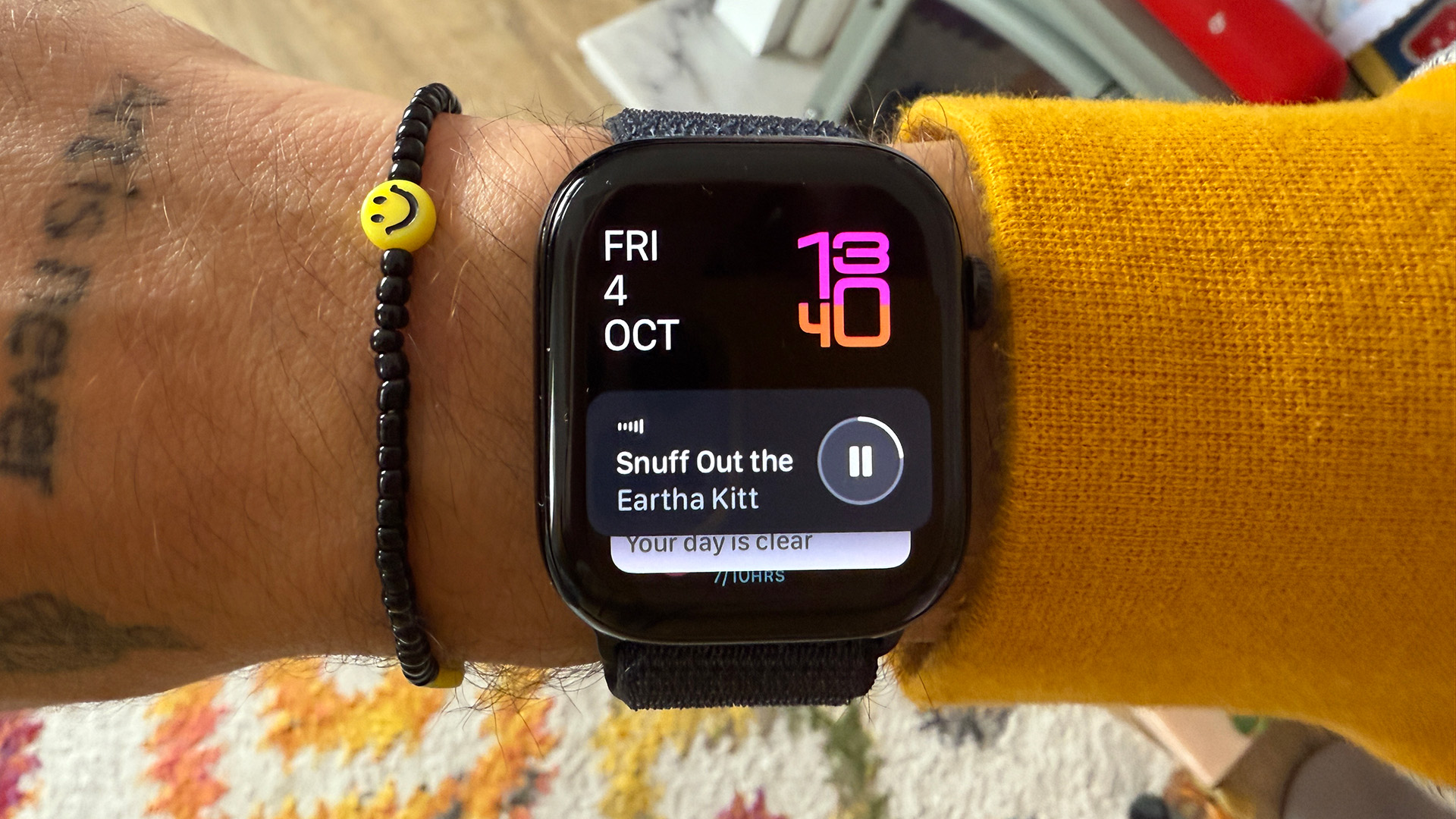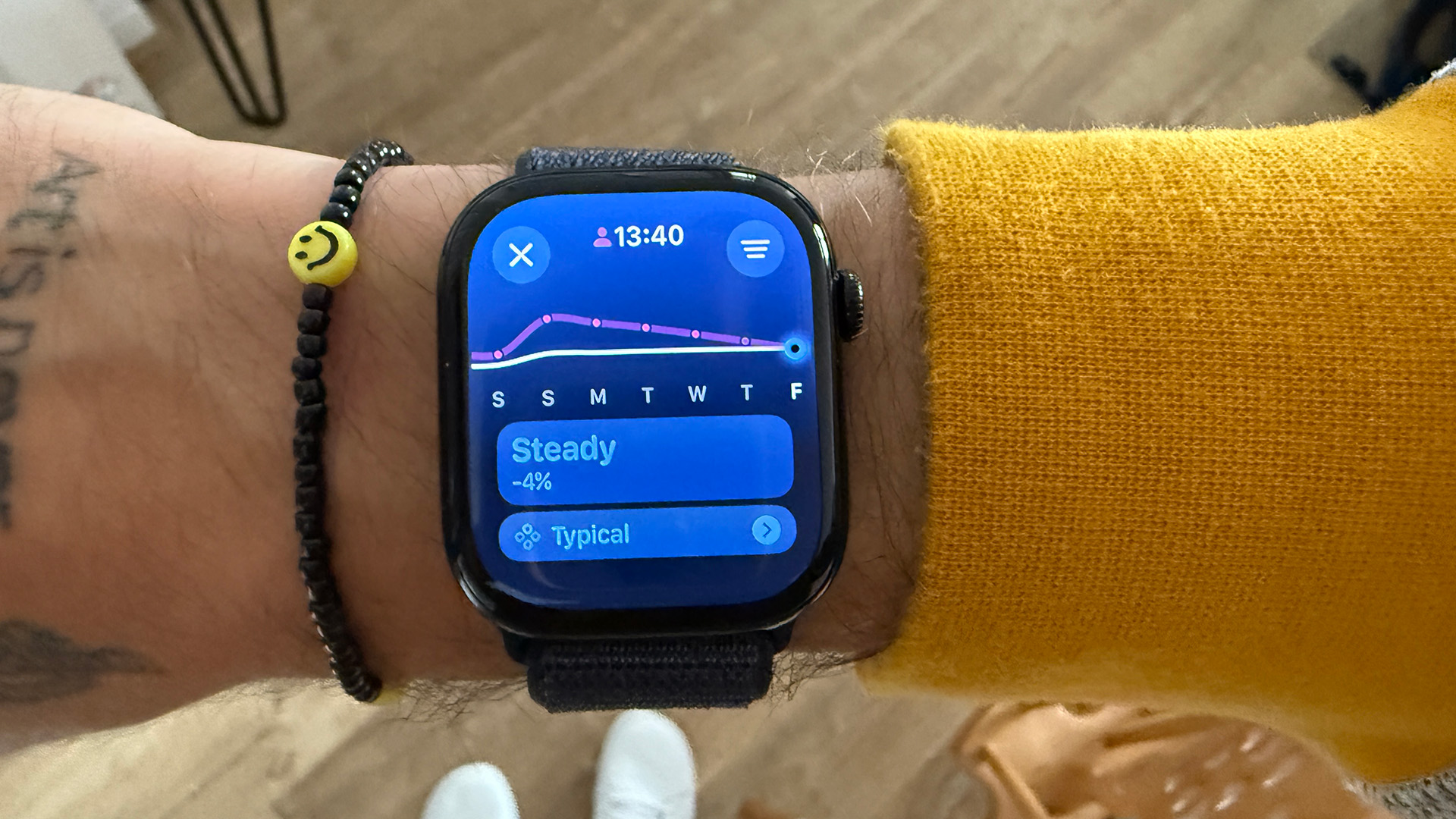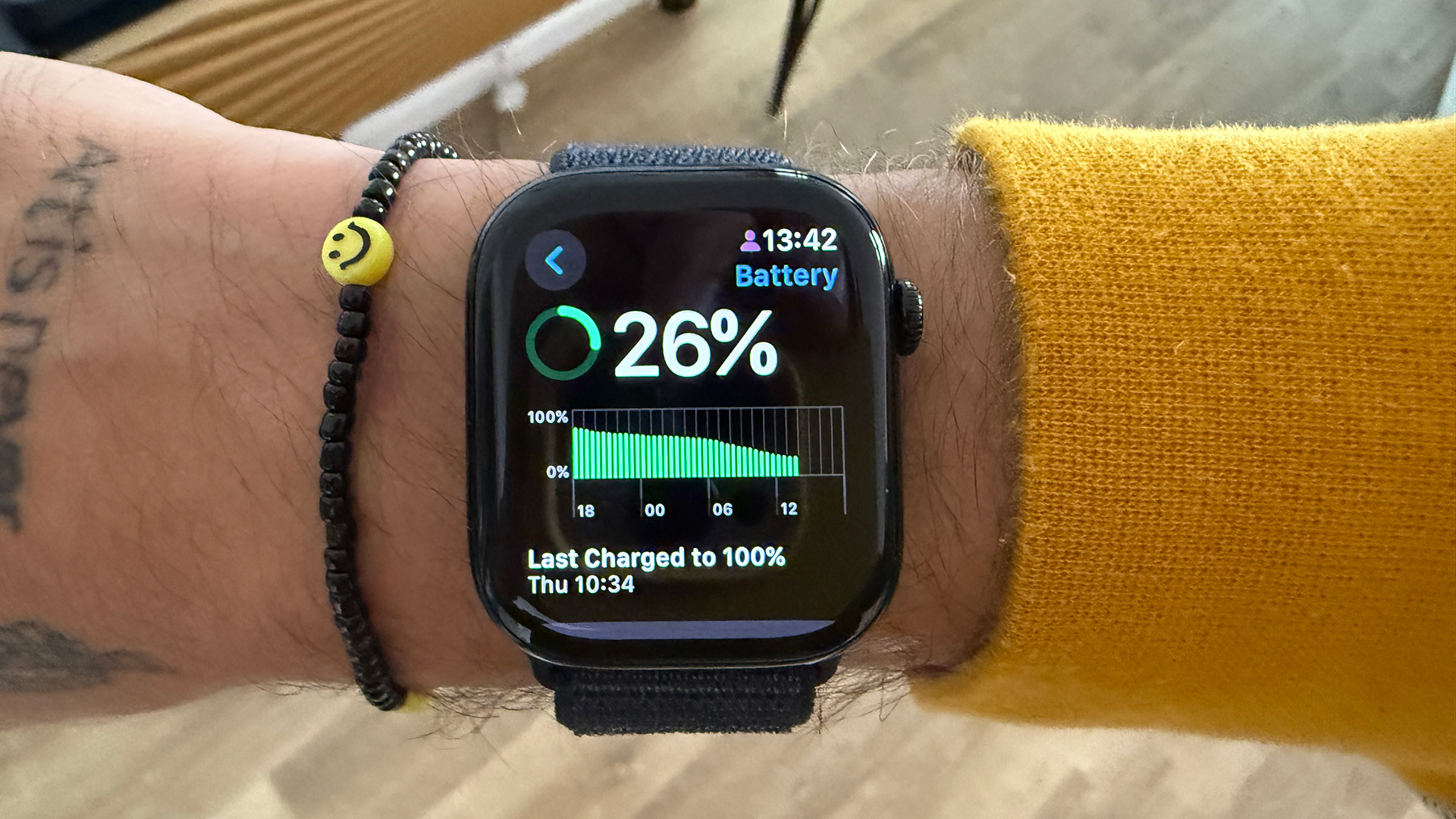Apple Watch Series 10 review: Slimmer, sleeker, but familiar ground
Apple’s latest wearable offers subtle upgrades for those who demand the latest


The Apple Watch Series 10 refines its winning formula with a slimmer design, larger display, and faster charging. New features like sleep apnea detection and voice isolation for calls add value, but incremental changes may not justify upgrading from Series 9. It’s polished but not groundbreaking – perfect for new users.
-
+
Slimmer design and lighter weight
-
+
Larger, bezel-reduced display with better off-angle visibility
-
+
Fast charging
-
+
Voice isolation for calls
-
-
No major design overhaul
-
-
Battery life remains unchanged
Why you can trust T3

I was watching Apple’s 2024 Special Event with bated breath, expecting nothing less than a revolution in the Apple Watch’s design for its 10th anniversary. Rumours were all over the place, making it hard to predict what would happen.
When the Apple Watch Series 10 was finally announced, it certainly wasn’t a complete overhaul of the world's most popular wearable. Instead, Apple tweaked the design yet again, adding a larger display and a speaker and (re)introducing materials such as titanium to the lineup.
I’m not disappointed; it’s a familiar experience to discuss iterative design improvements when reviewing the latest and best Apple Watches. Even though I always hope the next Apple Watch will be a big redesign, I agree that the future of wearables lies in software enhancements and not continuous overhauls of physical design.
All that said, how good is the Apple Watch Series 10, and how does it compare to the best smartwatches from other leading brands, such as Samsung and Google? I can tell you now that there is no need to upgrade from the Apple Watch Series 9, but there are plenty of features to consider if you have an older Apple wearable. Let’s get started!
Apple Watch Series 10 review
Price and availability
The Apple Watch Series 10 comes in various models and configurations, with pricing dependent on the material (aluminium or titanium) and size (42mm or 46mm).
In the UK, the 42mm aluminium model of the Apple Watch Series 10 starts at £399, while the 46mm version is priced at £439. If you opt for the titanium version, prices begin at around £849 for the 42mm and rise to £889 for the 46mm model. Both models are available at Apple UK and online retailers like John Lewis and Currys, typically with the option of immediate shipping or in-store collection. The LTE-enabled versions, which allow independent cellular connectivity, add around £100 to the overall price.
In the US, the 42mm aluminium Apple Watch Series 10 starts at $399, and the 46mm aluminium model costs $429. The titanium models are more expensive, with the 42mm starting at $799 and the 46mm at $849. The Apple Watch Series 10 is available at Apple US, Best Buy, and carriers like Verizon and AT&T. LTE-enabled models also have a roughly $100 price bump.
Get all the latest news, reviews, deals and buying guides on gorgeous tech, home and active products from the T3 experts
In Australia, the 42mm aluminium version of the Series 10 starts at AU$649, and the 46mm model is priced at AU$699. For the premium titanium versions, prices start at AU$1,199 for the 42mm model and AU$1,249 for the 46mm version. Australian customers can purchase the Apple Watch Series 10 directly from Apple AU or through authorized retailers like JB Hi-Fi and The Good Guys. As in other regions, LTE versions will cost about AU$100 more than their GPS-only counterparts.
Colour options include Jet Black, Silver and Rose Gold for the aluminium models and Natural Titanium, Gold Titanium and Slate Gray Titanium for the titanium models.
Specifications
- Sizes: 42mm/ 46mm
- Case materials: aluminium and titanium
- Display type: OLED, Retina LTPO display with Always-On mode
- Display resolution: 352 x 430 pixels (42mm), 396 x 484 pixels (46mm)
- Maximum brightness: 2,000 nits
- Processor: S10 SiP
- Battery life: Up to 18 hours of typical usage
- Charging: Fast charging (up to 80% charge in under an hour)
- Durability: WR50 (up to 50 meters), IP6X, scratch-resistant Sapphire crystal on Titanium models; Ion-X glass on Aluminum models
- Weight (case only): Aluminium ~32g (42mm), ~39g (46mm), Titanium ~40g (42mm), ~47g (46mm)
- Connectivity: Wi-Fi, Bluetooth 5.3, GPS, optional LTE for cellular models
- Storage: 64GB internal storage
Design and build quality

At just 9.7 mm, the Series 10 is the slimmest Apple Watch to date and about 1 mm thinner than the Series 9. The aluminium case version also weighs 10 per cent less than the Series 9, and titanium cases weigh almost 20 per cent less than stainless steel.
The back of the watch has been refined with a more seamless, single-form metal design. The Series 10 also has more rounded corners and a slightly wider aspect ratio. The larger display options (42mm and 46mm) with reduced bezels allow more information to be shown on the screen. Despite these changes, the Series 10 looks and feels very similar to its direct predecessors.
One thing to add is that although the case size increased slightly, you can still use old bands with the Series 10. 41mm straps are compatible with the 42mm case, and the 45mm bands will work well on the larger 46mm case.
The titanium case returns and replaces the stainless steel option. The brand stopped offering mainline Apple Watches in titanium when the original Apple Watch Ultra was released. Titanium is more durable but weighs more than aluminium.
One of the more notable changes is the speaker, which allows the Series 10 to play sounds without a connected AirPods 4 (or any other AirPods). You can also use the speaker (and built-in microphone) to take phone calls and relive your favourite Knight Rider moments.
The Series 10 comes in six colours, including Jet Black, which fans have long requested. Unlike the more matte options, it’s a polished finish, which is a bold choice from Apple. I’m sure many people are slightly concerned about the scratch resistance of a polished black case, but I’m yet to see any blemishes on my Jet Black Series 10.
Display

The Apple Watch Series 10’s display is a notable improvement, especially compared to previous models. It offers larger screen sizes due to the reduced bezel, with more visible content on the screen. The 46mm version, in particular, can display one extra line of text, which is useful during workouts.
Both the 42mm and 46mm models have bright OLED displays that perform well in various lighting conditions. The brightness remains at 2,000 nits, the same as the Series 9, which means you won’t see a significant difference in direct sunlight.
The screen's visibility from an angle has improved, though. Apple says the Series 10 is 40 per cent brighter when viewed at an angle, thanks to the wide-angle OLED display. This is said to be advantageous when glancing at your notifications. However, unless you’re trying to sneakily check your WhatsApp messages on your wrist during a meeting, I’d say the wide-angle OLED doesn’t really shake up the overall user experience.
The screen refresh rate has improved. The Series 10’s OLED refreshes once a second when the screen is inactive. Apple even introduced new watch faces that take advantage of the 1Hz refresh rate, providing smoother animations even when the watch is in low-power mode.
It’s not quite on par with always-on MIP screens, but OLEDs are definitely getting there. For now, it’s a bit of a novelty that works only with a few watch faces. Strangely enough, some apps, like the stopwatch, haven't been swapped over to the new mode, but you can see the seconds changing during workouts, for example.
Hopefully, in time, we get to see non-MIP screens behaving like MIP screens without eating up all the battery in half an hour.
Features and performance improvements

The Apple Watch Series 10 runs on watchOS 11, bringing several new features that enhance its usability. The Smart Stack feature allows you to swipe through a stack of live widgets like weather, Activity Rings, or media controls, and now it also supports Live Activities from iPhone, such as tracking Uber rides or monitoring sports scores.
The S10 SiP does an excellent job of keeping up with the increased feature set of the Series 10. In classic Apple fashion, you can’t notice the difference between the performance of the Series 9 and the Series 10, but not because they are the same. Instead, it’s the S10 SiP handling more tasks with the same fluidity.
Admittedly, I got a little too excited about gesture control last time around (see my Series 9 review linked in the intro), but sadly, we’re yet to see any advancements there. I still think it has a lot of potential – just look at the new gesture control features of the Apple AirPods Pro 2 – but Apple clearly needs more time to roll out enhancements.
A feature unique to the Series 10 is voice isolation for calls. Using the new speaker and AI-powered algorithms, you can conduct calls from your wrist without the background noise getting in the way. I haven’t tried this feature in public, where everyone can eavesdrop on my conversations, but I think it’s a cool addition to the ever-growing feature set of the Apple Watch.
Health and fitness tracking

Health and fitness tracking remain central to the Apple Watch Series 10, with most of the core features carried over from previous models. Heart rate monitoring, ECG (electrocardiogram), and fall detection continue to function seamlessly, providing users with critical health insights.
A new addition is sleep apnea detection, which leverages the accelerometer to track breathing disturbances during sleep. This feature is not exclusive to the Series 10; it is also available on the Series 9 and Ultra 2 models. I don’t have sleep apnea, so I cannot test this feature on the Apple Watch or any other wearable (not too sad about it, I must say).
As you all know, blood oxygen (SpO2) monitoring has been disabled in Apple Watches in the US due to ongoing patent disputes, a limitation that might affect users who rely on that particular health metric. Despite this drawback, other health features remain robust, including sleep tracking, workout tracking, and the ability to take ECG readings.
Training Load is another feature added to make the Apple Watch a better workout companion. It provides insight into how workouts impact your body over time, making it easier to adjust workout intensity and recovery periods. This feature isn’t quite as robust as on Garmin watches, but it’s nice to see that Apple is trying.
Battery life and charging

Battery life on the Apple Watch Series 10 remains consistent with previous models, offering an 18-hour lifespan with regular usage. While this may not sound impressive compared to competitors, it is in line with Apple’s expectations for daily use.
Battery life is the same, but the Series 10 charges faster than older models. On paper, the watch charges up to 80% in just under an hour. I never let the battery die completely, but based on my test, the watches charged from about 20% to 50% in around 30 minutes and from 20% to 100% in 90 minutes.
Faster charging isn’t long battery life but it does provide some extra flexibility as long as you have an Apple Watch charger with you. Thankfully, many excellent travel chargers are available directly from Apple and third-party companies such as Belkin and Anker.
For those looking for a longer-lasting battery, the Apple Watch Ultra 2 may be a better option with its larger battery capacity. In summary, while the battery life hasn't changed much, the Series 10's faster charging helps offset that limitation for many users.
Verdict

The Apple Watch Series 10 continues Apple’s trend of refining rather than reinventing its flagship wearable. With its slimmer profile, larger display, and polished design, it’s a highly functional and aesthetically pleasing smartwatch, though perhaps not revolutionary.
The return of the titanium case and the introduction of voice isolation for calls offer something new for long-time Apple Watch users.
The new S10 chip handles the additional features smoothly, and while the improvements in the OLED display’s off-angle brightness and refresh rate are welcome, they’re not game-changing.
Health tracking remains solid, with the addition of sleep apnea detection, though the absence of SpO2 monitoring in the U.S. may be a drawback for some. Battery life hasn't seen a boost, but faster charging helps mitigate this.
All in all, while the Series 10 might not be a must-have for Series 9 owners, it’s a polished upgrade that cements its place as a premium option in the smartwatch market.
Also consider
Samsung Galaxy Watch 7: The newest version with advanced health tracking features, a larger AMOLED display, and Wear OS integration, perfect for Android users who want premium functionality.
Garmin Venu 3: A fitness-focused smartwatch with advanced health metrics, making it ideal for athletes or fitness enthusiasts who prioritize performance data.
Fitbit Sense 2: A cost-effective option offering robust health monitoring, including stress, sleep, and ECG tracking, great for those seeking wellness insights.
Huawei Watch GT 4: Offers long battery life (up to 14 days), stylish design, and excellent fitness tracking, making it a compelling option for those wanting durability and functionality in one package.

Matt Kollat is a journalist and content creator who works for T3.com and its magazine counterpart as an Active Editor. His areas of expertise include wearables, drones, fitness equipment, nutrition and outdoor gear. He joined T3 in 2019. His byline appears in several publications, including Techradar and Fit&Well, and more. Matt also collaborated with other content creators (e.g. Garage Gym Reviews) and judged many awards, such as the European Specialist Sports Nutrition Alliance's ESSNawards. When he isn't working out, running or cycling, you'll find him roaming the countryside and trying out new podcasting and content creation equipment.